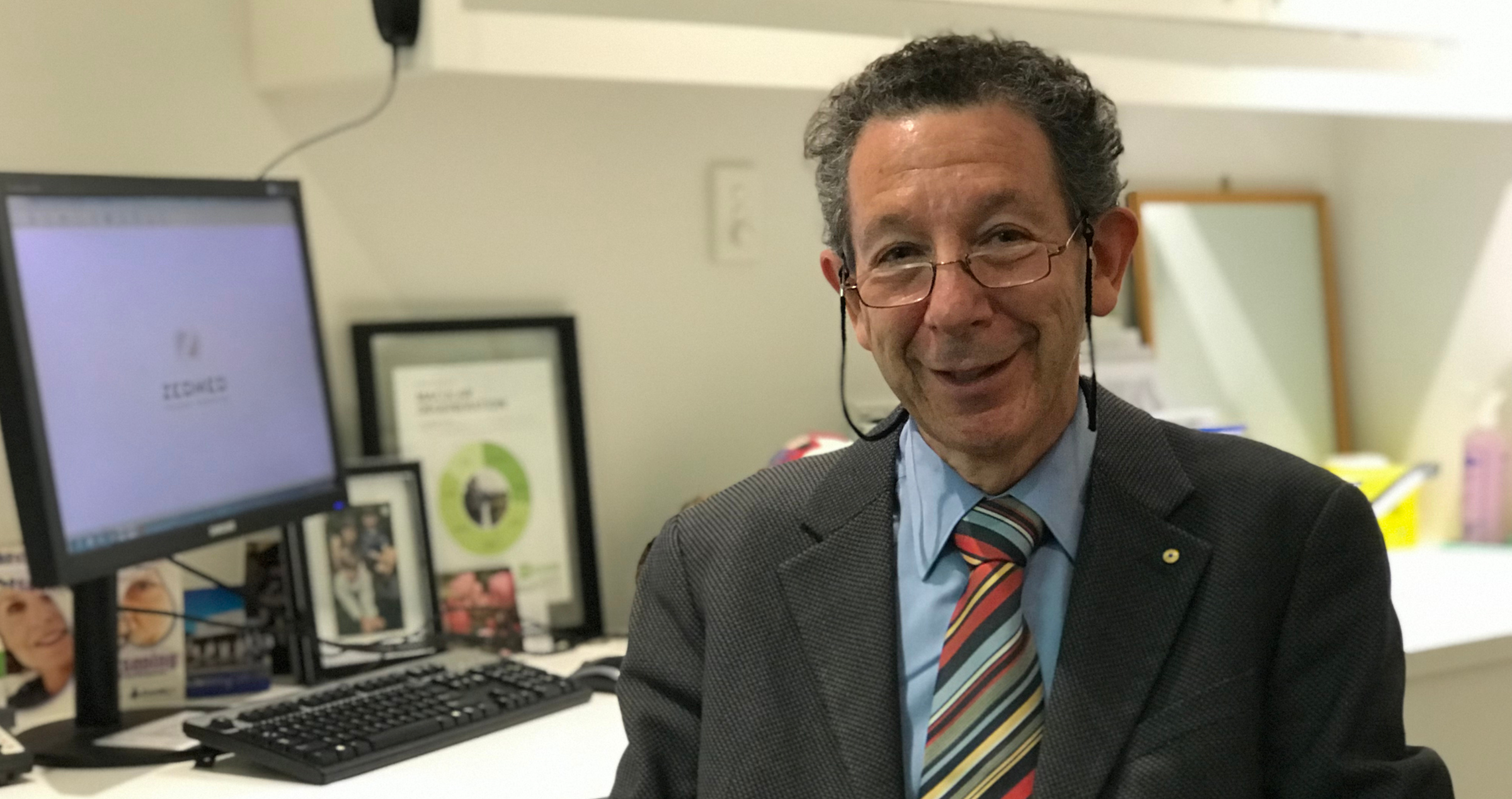Share
For the past 35 years, Glaucoma Australia has provided a single, unified voice on all things related to glaucoma. Glaucoma Australia co-founder Clinical Professor Ivan Goldberg spoke to mivision about the early days of the organisation and the challenges it still faces in raising community awareness.

In Ivan Goldberg’s study there’s a framed photograph of the Sydney Opera House. It was a gift from a long-term patient and a constant reminder of the importance of early intervention and treatment of glaucoma.
“This lady in her early 20s came to me blind in one eye from glaucoma with 90% loss of vision in the other eye. Her glaucoma in the remaining eye was completely out of control despite maximal therapy. She was desperate."
“This eye had had multiple surgeries beforehand, so the surgery she needed quickly was technically challenging and new at that time: insertion of a Molteno drainage device. Fortunately, she responded… her pressures came under good control and her glaucoma absolutely stabilised.”
When Professor Goldberg retired from clinical practice decades later, her vision was still intact.
“Her hobby was photography, believe it or not. About three years after (the surgery)… she came to me with a framed photograph she’d taken of the Opera House and said, ‘This is for you. It shows you what you have enabled me to see.'"
“And I mean, that moved me beyond words. I kept that in pride of place in my consulting room for 40 years, and when I retired, I took it home with me, and it’s now in my study at home.”
WIDER IMPACT
The story highlights the life-changing difference that appropriate treatment can make to glaucoma patients, and the importance of community awareness: the raison d’etre of Glaucoma Australia, the organisation founded by Prof (then Dr) Goldberg and others in 1986.
The association was incorporated two years’ later, and this year celebrates its 35th anniversary.
“When I came back from my fellowship in the United States in 1980 and set up practice… it became increasingly apparent that community awareness of glaucoma was woeful, that people were not having eye checks on a regular basis, and that people who had been diagnosed and were on treatment – partly because of a lack of understanding or knowledge or support – weren’t complying or persisting with their treatments so that the visual outcomes were not optimal."
“It seemed there needed to be a much wider availability of information on an individual and on a community basis. “It was also apparent that the amount of research being done into glaucoma and associated neurosciences in Australia was lagging the rest of the world,” Prof Goldberg said.
“So, it seemed that a lay organisation that would try to address these major issues was sorely needed, one that would run education campaigns for the community, one that would raise patients’ awareness and give them a support structure with information and guidance and support groups at all sorts of different levels, and at the same time, raise money to stimulate glaucoma-related research in our various universities.”
Prof Goldberg said, over a period of time, another area of need arose – the need for an advocate for people with visual disability, including people with glaucoma.
Initially, there was an attempt to “roll this into a more general eye disease associated foundation… but it was apparent that glaucoma, as a group of diseases, was not going to get the attention it needed, if you like, and be able to make the progress that was required, there needed to be a dedicated organisation.”
COMMITTED LEADERSHIP
Prof Goldberg said he is proud that the organisation was – and still is – independent.
“Right from the beginning, we have not been affiliated with any one hospital or any one university or any one medical centre or any one clinician. We’ve gone out of our way to make sure that it’s inclusive and it is national in its approach. I think we’ve achieved that.”
He said Glaucoma Australia has had a number of “extraordinary” chief executive officers.
“They’ve worked very hard. It is not a highly paid job. It’s one that people do as much out of altruism as they do for their careers. I’ve enjoyed working with all of them over these decades.”
But he singles out the late Kathleen Homes, a glaucoma patient he was treating, as someone who was integral to the formation of the organisation.
“I was thrilled and fortunate to find in one of my patients… someone who was highly intelligent, highly motivated, and had the time resources to do it. She was actually the moving force behind the creation of the charitable organisation, creating its legal structure and getting it off the ground."
“Kath was amazing. She was absolutely extraordinary. She was an angel who needs praises sung in her honour. She got an OAM (Medal of the Order of Australia) in recognition for what she’d done.”
THE NEED TODAY
It is estimated that in Australia, as in other western countries, up to 50% of people with glaucoma don’t know they’ve got the condition and so are not receiving any type of treatment.
Such is the nature of the “sneak thief of sight” that most people do not have warning signs or symptoms until moderate to severe visual damage has occurred. Treatment is available to slow or halt the disease process but not reverse it.
If undiagnosed and untreated – or inadequately treated – glaucoma can lead to visual loss and blindness.
One of the challenges for Glaucoma Australia is that it is difficult to measure the level of community awareness.
“We have hints of what has been achieved by diagnosis rates and by treatment rates and by the glaucoma medical market, the amount of money that is spent on the various drugs, the number of prescriptions that are filled, the number of operations that are performed, the number of laser treatments that are performed."
"So, have we made an impact or made a difference? One of the things we did manage to do was to help facilitate cooperation between optometrists and ophthalmologists. A lot of the screening for glaucoma became de facto optometric, became within their scope of practice."
“Ophthalmologists became the people who were the professionals that the optometrists referred the patients to, for confirmation of diagnosis, for initiation of a treatment program and subsequent oversight at least of that treatment. Glaucoma Australia actually helped to facilitate that collaboration and cooperation, and that has made an impact.”
He said encouraging optometrists to refer patients to Glaucoma Australia for information and support at the same time as they refer to ophthalmologists has also been successful.
FUTURE CHALLENGES
Going forward, Prof Goldberg said the focus of the organisation will remain unchanged. Community awareness of the disease to ensure earlier diagnosis is vital to saving sight.
“When… the disease itself produces no symptoms, you have to have community awareness. (People) need to have regular eye checks at a time in their lives when they are more at risk of developing the disease, which means increasing age. People who’ve got a family history (of glaucoma) have a tenfold increased lifetime risk for glaucoma; they need to start checking for it at an earlier age than people who don’t have a family history,” he said.
He said people living outside metropolitan areas have particular challenges with a chronic condition like glaucoma.
"The populations in regional and rural Australia, as you would guess, are affected by the same relative scarcity of access to glaucoma care as they are across the whole spectrum of medical care. Of course, once you’re treating a chronic disease, you’ve got this challenge of being able to access that care – not just once, for a short, acute episode and immediate treatment – this is ongoing. This is something that is lifelong.”
He said continued upskilling of eye health professionals was also crucial to “overcome some of the ‘red herrings’ that have bedeviled glaucoma diagnosis, namely an overreliance on raised pressure as one of the major diagnostic points”.
“We know it’s a very poor diagnostic parameter. Instead, there needs to be more concentration on what’s happening at the optic nerve head structurally, as well as backing it up with visual field tests functionally, he said. “That’s been helped enormously by advances in technology that have made these tests more accessible, cheaper, and much more accurate.”
This article has been republished courtesy of Mivision.
References:
1. Tham Y.C., Li X., Wong T.Y. et al., Global prevalence of glaucoma and projections of glaucoma burden through 2040: a systematic review and meta-analysis. Ophthalmology. 2014 Nov;121(11):2081–90.
2. Flaxman S.R., Bourne R.R.A., Resnikoff S. et al., Global causes of blindness and distance vision impairment 1990-2020: a systematic review and meta-analysis. Lancet Glob Health. 2017 Dec;5(12):e1221–34.
3, Holden B.A., Fricke T.R., Wilson D.A. et al., Global Prevalence of Myopia and High Myopia and Temporal Trends from 2000 through 2050. Ophthalmology. 2016 May;123(5):1036–42.
4. Ha A., Kim C.Y., Shim S.R. et al., Degree of Myopia and Glaucoma Risk: A Dose-Response Meta-analysis. Am J Ophthalmol. 2022 Apr;236:107–19.
5. Quigley H.A., Broman A.T., The number of people with glaucoma worldwide in 2010 and 2020. Br J Ophthalmol. 2006 Mar;90(3):262–7.
6. Rochtchina E., Mitchell P., Projected number of Australians with glaucoma in 2000 and 2030. Clin Exp Ophthalmol. 2000 Jun;28(3):146–8.
7. Wensor M.D., McCarty C.A., Stanislavsky Y..L et al., The prevalence of glaucoma in the Melbourne Visual Impairment Project. Ophthalmology. 1998 Apr;105(4):733–9.
8. Dirani M., Crowston J.G., Taylor P.S. et al., Economic impact of primary open-angle glaucoma in Australia. Clin Exp Ophthalmol. 2011 Oct;39(7):623–32.
9. Keel S., Xie J., Foreman J. et al., Prevalence of glaucoma in the Australian National Eye Health Survey. Br J Ophthalmol. 2019 Feb;103(2):191–5.
10. Shaikh Y., Yu F., Coleman A.L., Burden of undetected and untreated glaucoma in the United States. Am J Ophthalmol. 2014 Dec;158(6):1121-1129.e1.
11. Stein J.D., Ayyagari P., Sloan F.A., Lee P.P., Rates of glaucoma medication utilization among persons with primary open-angle glaucoma, 1992 to 2002. Ophthalmology. 2008 Aug;115(8):1315–9, 1319.e1.
12. Lee P.P., Walt J.G., Doyle J.J. et al., A multicenter, retrospective pilot study of resource use and costs associated with severity of disease in glaucoma. Arch Ophthalmol. 2006 Jan;124(1):12–9.
13. Real J.P., Lafuente M.C., Palma S.D., Tártara L.I., Direct costs of glaucoma: Relationship between cost and severity of the disease. Chronic Illn. 2020 Dec;16(4):266–74.
14. Kymes S.M., Plotzke M.R., Li J.Z. et al., The increased cost of medical services for people diagnosed with primary open-angle glaucoma: a decision analytic approach. Am J Ophthalmol. 2010 Jul;150(1):74–81.
15. Prager A.J., Liebmann J.M., Cioffi G.A., Blumberg D.M., Self-reported Function, Health Resource Use, and Total Health Care Costs Among Medicare Beneficiaries With Glaucoma. JAMA Ophthalmol. 2016 Apr;134(4):357–65.
16. Traverso C.E., Walt J.G., Kelly S.P. et al., Direct costs of glaucoma and severity of the disease: a multinational long term study of resource utilisation in Europe. Br J Ophthalmol. 2005 Oct;89(10):1245–9.
17. Poulsen P., Buchholz J., Walt J., Christensen J.. Cost-analysis of glaucoma-related blindness in Europe. International Congress Series. 2005;International Congress Series(2005):262–6.
18. Thygesen J., Aagren M., Arnavielle S. et al., Late-stage, primary open-angle glaucoma in Europe: social and health care maintenance costs and quality of life of patients from 4 countries. Curr Med Res Opin. 2008 Jun;24(6):1763–70.
19. Javitt J.C., Zhou Z., Willke R.J., Association between vision loss and higher medical care costs in Medicare beneficiaries costs are greater for those with progressive vision loss. Ophthalmology. 2007 Feb;114(2):238–45.
20. Haymes S.A., Leblanc R.P., Nicolela M.T. et al., Risk of falls and motor vehicle collisions in glaucoma. Invest Ophthalmol Vis Sci. 2007 Mar;48(3):1149–55.
21. Ivers R.Q., Cumming R.G., Mitchell P., Attebo K., Visual impairment and falls in older adults: the Blue Mountains Eye Study. J Am Geriatr Soc. 1998 Jan;46(1):58–64.
22. Felson DT, Anderson JJ, Hannan MT, Milton RC, Wilson PW, Kiel DP. Impaired vision and hip fracture. The Framingham Study. J Am Geriatr Soc. 1989 Jun;37(6):495–500.
23. Owsley C., McGwin G., Vision impairment and driving. Surv Ophthalmol. 1999;43(6):535–50.
24. Wang J.J., Mitchell P., Cumming R.G., Smith W., Blue Mountains Eye Study. Visual impairment and nursing home placement in older Australians: the Blue Mountains Eye Study. Ophthalmic Epidemiol. 2003 Feb;10(1):3–13.
25. Freeman E.E., Egleston B.L., West S.K., Bandeen-Roche K., Rubin G., Visual acuity change and mortality in older adults. Invest Ophthalmol Vis Sci. 2005 Nov;46(11):4040–5.
26. Salive M.E., Guralnik J., Glynn R.J. et al., Association of visual impairment with mobility and physical function. J Am Geriatr Soc. 1994 Mar;42(3):287–92.
27. Bramley T., Peeples P., Walt J.G., Juhasz M., Hansen J.E., Impact of Vision Loss on Costs and Outcomes in Medicare Beneficiaries With Glaucoma. Archives of Ophthalmology. 2008 Jun 9;126(6):849–56.
28. Atik A., Barton K., Azuara-Blanco A., Kerr N.M., Health economic evaluation in ophthalmology. Br J Ophthalmol. 2021 May;105(5):602–7.
29. Berenson K.L., Kymes S., Hollander D.A. et al., Patel VD. Cost-offset analysis: bimatoprost versus other prostaglandin analogues in open-angle glaucoma. Am J Manag Care. 2011 Sep 1;17(9):e365-374.
30. Stewart W.C., Stewart J.A., Mychaskiw M.A., Cost-effectiveness of latanoprost and timolol maleate for the treatment of glaucoma in Scandinavia and the United Kingdom, using a decision-analytic health economic model. Eye (Lond). 2009 Jan;23(1):132–40.
31. Noecker R.J., Walt J.G., Cost-effectiveness of monotherapy treatment of glaucoma and ocular hypertension with the lipid class of medications. Am J Ophthalmol. 2006 Jan;141(1 Suppl):S15-21.
32. Pen C.L., Ligier M., Berdeaux G., Cost-effectiveness and cost-utility analysis of travoprost versus latanoprost and timolol in the treatment of advanced glaucoma in five European countries: Austria, France, Germany, The Netherlands and the United Kingdom. Journal of Medical Economics [Internet]. 2008 Dec 2 [cited 2022 Dec 19]; Available from: https://www.tandfonline.com/doi/abs/10.3111/200508065084.
33. Xu C., Guo R., Huang D., et al., Daily Costs and Cost Effectiveness of Glaucoma Fixed Combinations in China. Journal of Ophthalmology. 2020 Aug 10;2020:e2406783.
34. Deschaseaux-Voinet C., Lafuma A., Berdeaux G., Cost and effectiveness of brinzolamide versus dorzolamide in current practice: an analysis based on the UK-GPRD database. Journal of Medical Economics. 2003 Jan 1;6(1–4):69–78.
35. Stewart W.C., Stewart J.A., Nasser Q.J., Mychaskiw M.A., Cost-effectiveness of treating ocular hypertension. Ophthalmology. 2008 Jan;115(1):94–8.
36. Okeke C.O., Quigley H.A., Jampel HD, Ying G shuang, Plyler RJ, Jiang Y, et al. Adherence with topical glaucoma medication monitored electronically the Travatan Dosing Aid study. Ophthalmology. 2009 Feb;116(2):191–9.
37. Friedman D.S., Quigley H.A., Gelb L. et al., Using pharmacy claims data to study adherence to glaucoma medications: methodology and findings of the Glaucoma Adherence and Persistency Study (GAPS). Invest Ophthalmol Vis Sci. 2007 Nov;48(11):5052–7.
38. Gazzard G., Konstantakopoulou E., Garway-Heath D. et al., LiGHT trial: 6-year results of primary selective laser trabeculoplasty versus eye drops for the treatment of glaucoma and ocular hypertension. Ophthalmology. 2022 Sep 16;S0161-6420(22)00732-1.
39. Khawaja A.P., Campbell J.H., Kirby N. et al., Real-World Outcomes of Selective Laser Trabeculoplasty in the United Kingdom. Ophthalmology. 2020;127(6):748–57.
40. Gazzard G., Konstantakopoulou E., Garway-Heath D., et al. Selective laser trabeculoplasty versus eye drops for first-line treatment of ocular hypertension and glaucoma (LiGHT): a multicentre randomised controlled trial. The Lancet. 2019 Apr 13;393(10180):1505–16.
41. Atik A., Rhodes L.A., Samuels B.C. et al., Cost Utility of Schlemm’s Canal Microstent Injection With Cataract Surgery for Open-angle Glaucoma in the US Medicare System. Journal of Glaucoma. 2022 Jun;31(6):413–22.
42. Sood S., Heilenbach N., Sanchez V. et al., Cost-Effectiveness Analysis of Minimally Invasive Trabecular Meshwork Stents with Phacoemulsification. Ophthalmology Glaucoma [Internet]. 2021 Sep 23 [cited 2021 Oct 26];0(0). Available from: https://www.ophthalmologyglaucoma.org/article/S2589-4196(21)00210-6/fulltext.
43.Ahmed I.I.K., Podbielski D.W., Patel V. et al., A Canadian Cost-Utility Analysis of 2 Trabecular Microbypass Stents at Time of Cataract Surgery in Patients with Mild to Moderate Open-Angle Glaucoma. Ophthalmology Glaucoma. 2020 Mar 1;3(2):103.
44. Lavia C., Dallorto L., Maule M. et al., Minimally-invasive glaucoma surgeries (MIGS) for open angle glaucoma: A systematic review and meta-analysis. PLoS One. 2017;12(8):e0183142.
45. Atik A., Fahy E.T., Rhodes L.A. et al., Comparative Cost-effectiveness of Trabeculectomy versus MicroShunt in the US Medicare System. Ophthalmology. 2022 Oct;129(10):1142–51.
46. Baker N.D., Barnebey H.S., Moster M.R. et al., Ab-Externo MicroShunt versus Trabeculectomy in Primary Open-Angle Glaucoma: One-Year Results from a 2-Year Randomized, Multicenter Study. Ophthalmology. 2021 May 27;S0161-6420(21)00384-5.


